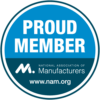Have any of you ever had a small pebble in your shoe that made it uncomfortable to walk, but you just ignored it and continue until you had the time to remove it or found you couldn’t take it anymore? To those of you that answered no, I salute you, because either it’s never happened to you or you took care of the annoyance immediately.
However, many of us hope the little nuisance will get better over time. Maybe it’ll just go away, or maybe we just push through it because we are too busy to stop and investigate the problem.
What I just described is a situation that will only get worse over time, and if unresolved, put unnecessary pain, stress, and uncomfortableness on our body. This example brings me to the topic of ergonomics in the workplace.
A non-ergonomic work environment can lead to fatigued, frustrated, or injured workers, and can result in lower productivity, poor product quality, and negative feedback.
How many of our work tasks or daily activities do we continue to perform while being uncomfortable — pushing our bodies to get the job done? Wouldn’t it be better to perform the job or task each day in an atmosphere that provides the least amount of stress on our bodies? If your answer is yes, then implementing ergonomic solutions in the workplace will help to achieve this goal.
Ergonomics is defined as the science of creating a working environment that suits the capabilities and limitations of the worker while simultaneously maximizing efficiency. A non-ergonomic work environment can lead to fatigued, frustrated, or injured workers, and can result in lower productivity, poor product quality, and negative feedback.
Alternately, the positive attributes and benefits of integrating workplace ergonomics include reduced costs, improved productivity and quality of work, increased employee engagement, all while encouraging a better safety and health culture within the organization or business. These benefits sound great for workers, management and owners of an organization, but how do you implement ergonomic solutions in the workplace?
Step 1: Consider the primary workplace ergonomic risk factors
High Task Repetition: Many work tasks and cycles are repetitive and frequently controlled by hourly or daily production targets and work processes. A job is considered highly repetitive if the cycle time is 30 seconds or less. High task repetition, when combined with other risk factors such as high force and/or awkward postures, can contribute to a potential injury.
Forceful Exertions: Many work tasks require high force loads on the human body. Muscle effort increases in response to high force requirements, increasing associated fatigue, which can lead to a potential injury.
Repetitive/Sustained Awkward Postures: Awkward postures place excessive force on joints and can overload the muscles and tendons around the affected joint. Joints of the body are most efficient when they operate closest to the mid-range motion of the joint. The risk of injury is increased when joints are worked outside of this mid-range repetitively or for sustained periods of time without adequate recovery time.
Step 2: Identify and categorize
Now that you’ve established the risk factors, it is necessary to identify the jobs or tasks in your organization that would fall into any of these ergonomic risk factor categories. These jobs or tasks would then be prioritized to determine the order of importance of finding ergonomic solutions. Ergonomic solutions can be achieved by using engineering controls, administrative controls, work practice controls and job rotation.
- Engineering controls are developed to eliminate excessive force and awkward posture requirements that will reduce worker fatigue and allow high repetition tasks to be performed safer and more efficiently.
- Administrative controls establish processes and procedures that can reduce injury risk while completing work tasks.
- Workers should be trained in proper work techniques and accept their responsibility to use their body properly and avoid awkward postures whenever possible.
- By implementing job rotation, workers can rotate between different workstations and tasks to avoid prolonged periods of time performing a single task. This will help reduce fatigue.
Step 3: Evaluate effectiveness
Once the ergonomic solutions to the identified problematic jobs and tasks have been introduced into the workplace, we can then evaluate the effectiveness of the solutions. Effectiveness can be evaluated in several ways:
- Did the changes provide a safer workplace in which there was a noticeable decline in incidents and injuries?
- Have employees experienced increased morale as a result of a better working condition that inflicts less physical exertion and body movements?
- Has production increased due to more efficient work stations?
- Has quality is increased due to workers being less frustrated and tasks being less taxing on the body that creates fatigue and exhaustion?
I believe establishing ergonomic solutions in the workplace is critical for any organization. The benefits far outweigh the costs. Ergonomics in the workplace should be evaluated often to ensure not only effectiveness but also identify any areas for improvement. I feel that providing a strong commitment to ergonomics is essential for an organization’s quest for continuous improvement. The choice is yours — you can walk around with the pebble in your shoe and still get the job done. But, wouldn’t it be much easier to remove the problem and work more comfortably?
Written by: Randy Plunkett





 简体中文
简体中文 Nederlands
Nederlands English
English Français
Français Deutsch
Deutsch हिन्दी
हिन्दी Italiano
Italiano 日本語
日本語 한국어
한국어 Português
Português Русский
Русский Español
Español ไทย
ไทย